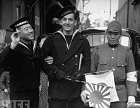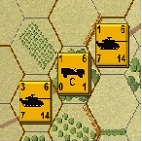James Fennell
Posts: 135
Joined: 12/25/2010
From: Gloucestershire
Status: offline

|
Infantry
From 1948-50 British infantry and Royal Marines Commandos and RAF Regiment Field Squadrons were all armed with the WW2 SMLE Mk III bolt action rifle and sniper rifle as well as the newer SMLE Mk 5 'Jungle Carbine'. Some units, notably paratroopers, also had US Browning M1 semi-auto Carbines. Late production Sten Mk 5 9mm SMGs were standard issue as well as Bren LMGs. Every platoon had a 2" smoke mortar and a PIAT anti-tank weapon. Heavy weapons were mostly WW2 vintage - OBL 3" and 4.2" mortars, Vickers Medium Machine Guns and 6 pounder anti-tank guns, although a few units had an experimental 3.45" RCLR. Some 12.7mm HMGs and 20mm Polsten AA guns were allocated to elite light infantry and paratroopers. Tactically they were still using WW2 training and the Army was made up of mostly conscripts.
From 1950-56 improvements inlcuded the adoption of the vastly better Pachett Sterling 9mm SMG, while the PIAT was replaced by the US M20 90mm "Super Bazooka' and the Belgian-designed ENERGA anti-tank rifle grenade was issued at section level as well as combat shotguns in Malaya. A new hand grenade also replaced the venerable Mills Bomb. Overall the anti-tank and anti-structure power of the platoon increased and in Malaya it had more short ranged automatic weapons. Heavy weapons also improved with the adoption of the 120mm BAT RCLR for motorised and armoured infantry and the US 106mm RCLR for light infantry, paratroops and marines. The WW2 vintage 6 pounder and 17 pounder AT guns were retired.`Significant lessons were learned in Korea, Malaya and Suez that brought about the end of conscription, new weapons and a tactical and training rethink for the new 'all professional' infantry from 1957.
The modern SAS was re-born during this period in Malaya (initally being called the Malaya Scouts), and was armed with a mix of Brens, Australian Owen Gun SMGs, Patchett Sterlings, M1 Carbines and SMLE Mk 5 'Jungle Carbines'. The SBS was also reformed from the School of Combined Operations and SBS teams were deployed behind the lines from submarines in the Korean war.
From 1957-62 the new 7.62mm FN FAL 'SLR' began to replace the SMLE. Colonial troops and armed police still kept the SMLE. Also a 7.62 chambered version of the Bren, the L7A1 'LMG' was introduced to replace the Bren. The MOBAT, a more mobile version of the 120mm BAT RCLR replaced the BAT in general use and some light infantry units received Vigilant ATGMs. Overall the firepower and mobiliy of the platoon increased. This period saw the end of national service (conscription) and some sigificant improvements in fire and movement training, learning from lessons identified from analysis of WW2 and Korea on both sides of the Atlantic. Some units began to specialise in desert, jungle and arctic warfare too.
From 1962-84 the platoon replaced the M20 and ENERGA combination with the 84mm Carl Gustav at platoon level and the US M72 LAW at section level. The Vickers Medium Machine Gun was replaced by the FN MAG 7.62 GMPG (or Gimpy to the troops) in 1962 and bipod versions were issued at section level to some units like armoured infantry, paras, marines and SAS from 1964. The L42A1 7.62mm sniper rifle was introduced in 1971 and The new L19 81mm mortar replaced the OBL 3" from 1962, although the 2" smoke mortar and 4.2" heavy mortar were retained (the 4.2" in airborne units). SAS and SBS units in Borneo, Oman and Northern Ireland received the M16A1/A2 assault rifle and 40mm UGL. The professional army units of this period were highly capable with excellent training and firepower.
From 1962 the lightwieght WOMBAT 120mm RCRL replaced the 106mm RCRL in light infantry, airborne and commando units and supplemented the MOBAT in regular infantry units. The SLR, SMG, LMG and GPMG incrementally improved with nylon/glass fibre furniture, the SUIT 4 x optical sight for designated marksmen and GPMG gunners and so on. The 4.2" Mortar was phased out in 1975 and the Milan ATGM replaced the WOMBAT RCLR from 1978. HK MP5 and MAC-10 SMGs were also used by SAS and SBS units. A number of specialised covert reconnaissance and counter-terrorist units were formed such as 14 Intelligence Company in Northern Ireland and the Counter-Revolutionary Warfare Group within 22 SAS.
From 1984-85 the SLR, Sterling SMG and L7 LMG were replaced with the L85A1 5.56mm Assault Rifle and L86A1 5.56mm Light Support Weapon (LSW). 7.62mm GPMGs were issued at platoon level to armoured infantry and the Carl Gustav/LAW combination was replaced by a single AT weapon issued at section level, the 94mm LAW-80. The improved Milan 2 ATGM replaced the Milan and remaining WOMBAT RCRLs. Both close combat firepower and antitank strength improved although long range hitting power anti-structure capacity reduced somewhat. The excellent L96 sniper rifle entered service in 1982 and provided an important improvement in long ranged firepower.
The picture is taken in Aden and shows the ENERGA HEAT rifle grenade mounted on a L1A1 SLR.

 Attachment (1) Attachment (1)
< Message edited by James Fennell -- 8/15/2020 4:13:31 PM >
_____________________________
....gone to the dark side
|
 Printable Version
Printable Version


































 New Messages
New Messages No New Messages
No New Messages Hot Topic w/ New Messages
Hot Topic w/ New Messages Hot Topic w/o New Messages
Hot Topic w/o New Messages Locked w/ New Messages
Locked w/ New Messages Locked w/o New Messages
Locked w/o New Messages Post New Thread
Post New Thread